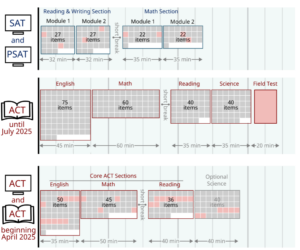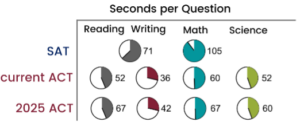Posted by: Aaron Golumbfskie on February 4, 2025
The ACT “Enhancements” that were announced last year will begin on a small scale in April and for all students in September. Current juniors in the class of 2026 are already asking themselves, “Should I take the current ACT or the Enhanced ACT?” since they’re in the unique position of being able to choose: they can stick with the current ACT through the spring and summer, or they can start taking the new test in April, knowing it’ll be the same in the fall if they to continue testing to reach their goal scores.
Our best advice for almost all students is to take the current ACT and not the new digital ACT. That’s not surprising, since there’s usually a period of adjustment for any new test while its creators fine tune both the content on the test and the consistency of its delivery. During that time, students have fewer and less accurate practice resources with which to work, and tutors and teachers have less understanding of the test, typically resulting in more variability in scores and more anxious students. In the case of this new ACT, though, particular design choices have been made that render the test even more susceptible to this sort of volatility, so if you’re a high school student or a parent, don’t even consider taking the new ACT until you have to in September.
How are the structure and length of the ACT changing?
The ACT is about to do something it rarely does: change. The new ACT “Enhancements” announced last year represent the greatest changes the test has seen in almost 40 years. While the SAT has existed in no fewer than six different incarnations in that time, the ACT has remained relatively unchanged since the last major revision in 1989. It’s been the same four English, Math, Reading and Science sections ever since. Until now, that is. Going forward the ACT Science section will be optional and no longer a part of the “Core” ACT.
On the one hand, it’s difficult to understand why the ACT would choose now to drop the Science section. We live in an ever increasingly technological society, understanding data and science is necessary to be an informed citizen no matter what path in life you choose, and American students are consistently lagging behind others in tests of science proficiency. On the other hand, it’s crystal clear why the ACT dropped the Science section. Time. Their competitor, the College Board, debuted a newly revised digital SAT last year that checks in at a svelte 2 hours and 14 minutes of tested time, compared to the current ACT’s 3 hours and 20 minutes, if you include the field test items at the end of the exam. Many students and schools have been choosing the SAT simply because it’s the shorter test, and the ACT needed to change to compete.
The figure below depicts the structural changes to the test. The Core ACT now consists of 131 items in 2 hours and 5 minutes of tested time. That’s much more in line with the new SAT’s 98 items in 2 hours and 14 minutes and preserves the more speeded nature of the ACT compared to SAT. While many critics have pointed to the length of standardized tests as an unnecessary barrier to student success, and many students will surely welcome a shorter testing experience, that benefit comes at a cost. And the cost is the precision of the test. The SAT recently cut almost an hour from its test, but it did so by transitioning to a computer adaptive test. The difficulty of questions students encounter on the SAT depends on how accurately they’ve answered the questions they’ve already seen. Thus, College Board was able to decrease the total tested time on the SAT while still maintaining its accuracy.



The new ACT, however, will remain a static, linear test. It’s not adaptive and doesn’t change to match students’ ability levels, so the reduced number of questions will necessarily result in more score variability. What’s more, ACT has finally made the responsible decision to incorporate the field test items – questions that are being tested and do NOT contribute to student’s scores – into the test sections themselves so that they can gather more accurate data. The Reading section, for example, now only has 27 scored items and a score scale of 1-36. That’s not a lot of granularity. The ACT knows this and, to its credit, has released the data. The Reliability score of that section has decreased from a 0.89 to a 0.84. That might not seem like much, but – like many test questions – it’s just a math trick. The reliability is on a scale of 0 to 1 and is the opposite of the variance of the test, which has thus gone from 0.11 to 0.16, an almost 50% increase. To students for whom every point matters, that’s quite a jump.
It remains to be seen whether the ACT can deliver on the promise of a shorter, static test that retains its predictive validity. The good news here is that the ACT – unlike the College Board – still plans to continue its Test Information Release program, so we’ll be able to monitor those “curves” on future tests and hope to re-evaluate our opinion.
What ACT content is changing?
In addition to the more obvious large-scale structural changes noted above, updates have also been made to each of the section blueprints – that is, the percentages of different types of problems that make up each section. ACT makes these sorts of pedagogical adjustments every few years, taking into account feedback from stakeholders at both high school and university levels. The changes to each of the sections are noted in the table below.
Content Changes for 2025 ACT
| English | • The section will continue to be passage based, requiring students to incorporate greater context. • All questions, even grammar questions, will have a question stem. • Grammar questions will be deemphasized and replaced with questions about the production of writing: its purpose, structure and the author’s goals. |
| Math | • An effort has been made to reduce the wordiness of the math section. • The content of the test is on balance the same level of difficulty, yet has changed at the margins: the ACT is deemphasizing both basic skills questions and the most academically advanced content on the test. |
| Reading | • The reading passages are slightly shorter and feature 9 rather than 10 questions each. • Test questions will focus less on details and main ideas and more on recognizing arguments and evidence and separating fact from opinion. • The level of diction and abstraction required from students to understand the passages is expected to increase. |
| Science | • Passage will have an increased focus on engineering and technology applications in addition to the basic science currently found on the test. • More background content knowledge may be required to navigate questions on the new, optional Science section. |
Most of these changes move the test in the right direction. Those wordy, basic skills math questions were always amongst the most poorly performing on the test. And actually requiring science content knowledge on a section entitled “Science” is a good thing. We, of course, lament the loss of grammar on the test. While we understand stakeholders report that students have digital tools and no longer need to know grammar rules themselves, we’d take the ACT’s newfound commitment to honoring digital tools more seriously if they’d integrate a modern calculator into their testing platform! Ultimately, however, it’s too soon to really know how the content changes might compare with those recently made to the SAT last year. It’s likely the case, however, that the stereotypes we know will continue to ring true: the ACT is the more speeded yet straightforward test, and the SAT is the slower-paced, “trickier” test.
How will the ACT be delivered?Will the new ACT be on paper or on a computer?
While the adaptive SAT must be taken on a computer using the College Board BlueBook app, the ACT has pledged to continue to offer the new ACT both in paper and digital formats, a move that’s great for students, who now have a choice as to which format to take. The roll-out of the digital test, however, has not been smooth. Unlike the SAT, which may be taken on personal devices, the digital ACT in its current form must be taken on school managed devices. That’s turned out to be a difficult pill for schools to swallow, leading to fewer test sites for the digital test. For example, the closest digital testing site to the DC Metro area for the April test is in Dallastown, PA, over 60 miles away. But a paper test? Plenty of seats available. Providing proctors for a few hundred test takers on a weekend may be a hassle; scrounging up functional, charged computers for every one of those students is a true challenge. The ACT is piloting a bring-your-own-device program now, which they’ll likely need for the test to be accessible as it has to be for widespread adoption.
If the ACT wants its digital tool to be successful, it also needs to standardize the experience. Right now, there are actually three slightly differing formats depending upon whether a student is taking the school day test, a national test, or an international test. And we’re not just talking about minor formatting issues here – one of those formats has the online calculator Desmos integrated, and the other two do not as of yet.
We applaud ACT’s efforts to maintain a paper test in the face of change, as there are students for whom that’s a definite advantage. But the future of standardized testing is digital, and the future is now. The ACT must update and smooth the digital experience for students if they want to remain competitive.
What will colleges make of the new ACT?
In the past, we’ve consistently overestimated the degree to which college admissions officers interrogate details of a standardized test score report. Now, our best advice is to focus on achieving the highest superscored composite score possible, since that tends to be the number many colleges care about the most. We don’t actually expect many or even any colleges to require the ACT Science section, just like we see very few colleges continuing to require the optional Writing (essay) section. It may be the case that students applying as STEM-focused candidates or to engineering schools may be required to take the Science section, or we may get the dreaded “recommended” rather than required. In the same way, if ACT decides to superscore the new ACT with the old ACT – and they likely will – most colleges will likely respond by entering that superscored number ACT provides into the field for “ACT Score”, just like they have been for years.
Final Thoughts
We haven’t even seen a full-length mock ACT yet, so it’s a little difficult to say much unequivocally about the new test. While there are the bones of a good exam here, the ACT has plenty of work to do before the test gets its full launch in September. The only thing that’s certain at this point is the uncertainty it brings, which is why we’re admonishing all our students to stick with the ACT they – and we – know.




